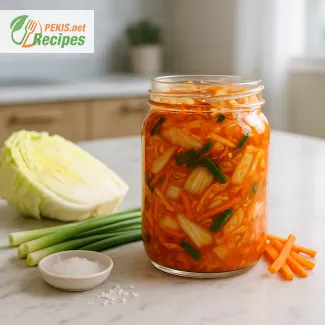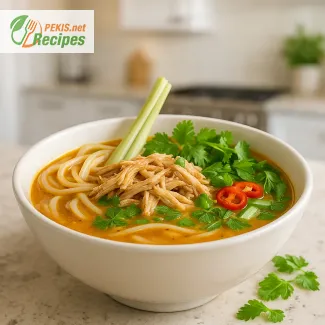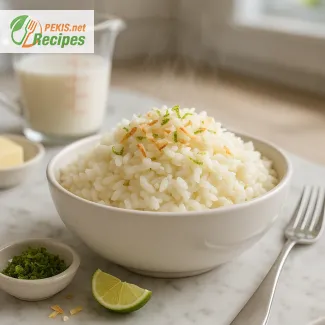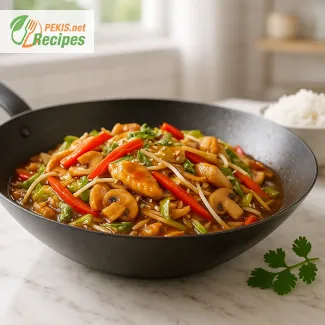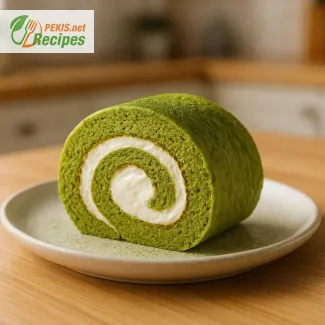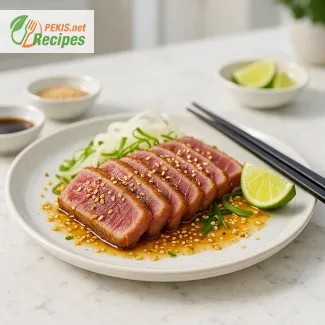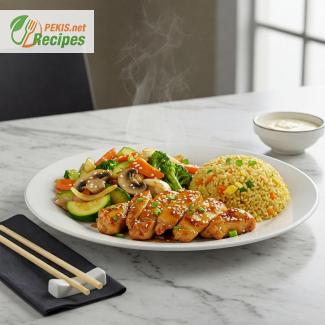
The Ultimate Guide to Making Authentic Chicken Hibachi at Home
What Makes Chicken Hibachi So Special?
There’s something truly captivating about the experience of hibachi cooking. The sizzling sounds, the tantalizing aromas, and the irresistible flavors come together in a perfect harmony that keeps diners coming back for more. Originating from Japanese teppanyaki-style grilling, chicken hibachi has become a staple dish in many Japanese steakhouses worldwide.
What sets hibachi apart is not just the cooking method, but the unique combination of flavors—tender chicken, crisp vegetables, and a perfectly balanced hibachi sauce that elevates the entire dish. With its smoky undertones and a slight sweetness, this Japanese-inspired dish is an explosion of umami in every bite.
In this guide, we’ll show you how to recreate the magic of hibachi-style cooking in your own kitchen. From choosing the right ingredients to achieving that signature hibachi flavor, get ready to transform your home dining experience with this restaurant-quality dish.
The Secret Behind Perfect Hibachi Chicken
If you’ve ever dined at a Japanese steakhouse, you know that hibachi is more than just a meal—it’s an experience. Chefs skillfully cook in front of guests, using expert knife skills and impressive grilling techniques. But even if you don’t have a teppanyaki grill, you can still achieve the same flavors with the right techniques and ingredients.
Key Elements of an Authentic Chicken Hibachi Dish
- High Heat Cooking:
The secret to the signature hibachi-style sear is using high heat. Whether you’re using a cast-iron skillet, griddle, or wok, getting the pan hot enough ensures that the chicken develops a deliciously caramelized crust. - The Right Sauce Blend:
The iconic hibachi sauce combines soy sauce, garlic butter, sesame oil, and mirin to create a rich, umami-packed glaze that coats every bite. Some variations include a touch of teriyaki sauce or ginger for added depth. - Fresh Ingredients:
Using fresh chicken breast or thighs ensures the meat remains juicy and tender. Accompanying vegetables like zucchini, mushrooms, onions, and carrots add a delightful crunch, balancing the dish perfectly. - The Famous Hibachi Butter:
One of the defining characteristics of hibachi cooking is the garlic butter. This flavorful butter is melted over the chicken and vegetables to create a rich, velvety texture that enhances every bite. - Rice and Noodles:
No hibachi meal is complete without fried rice or noodles. The perfect side dish absorbs all the delicious flavors from the hibachi grill, making every bite even more satisfying.
How to Recreate the Japanese Steakhouse Experience at Home
Preparing chicken hibachi at home is easier than you might think! With just a few key ingredients and a hot skillet, you can achieve the same bold flavors and tender textures that you love from your favorite Japanese restaurant.
Essential Ingredients You’ll Need
To make an authentic chicken hibachi dish, you’ll need:
- Chicken: Boneless, skinless chicken breast or thighs for the juiciest results.
- Vegetables: A mix of onions, zucchini, mushrooms, carrots, and bell peppers.
- Hibachi Sauce: A blend of soy sauce, sesame oil, garlic, and a touch of butter.
- Rice or Noodles: Hibachi fried rice or yakisoba noodles for the perfect side.
- Garlic Butter: A combination of melted butter and minced garlic for that classic hibachi taste.
Tips to Elevate Your Homemade Hibachi Chicken
Want to take your hibachi skills to the next level? Here are a few pro tips to ensure your dish is flavorful, aromatic, and perfectly cooked:
- Use a hot pan: Heat your pan for a few minutes before adding ingredients to create that signature hibachi sear.
- Don’t overcrowd the pan: Cooking in batches prevents steaming and ensures a golden-brown crust on the chicken.
- Let the chicken rest: After cooking, allow the chicken to rest for a few minutes before slicing. This helps retain the juices.
- Serve with a dipping sauce: Traditional hibachi white sauce (yum yum sauce) or ginger sauce adds an extra layer of richness and tang.
Why You’ll Love This Chicken Hibachi Recipe
This homemade chicken hibachi recipe brings the excitement of Japanese steakhouse dining straight to your kitchen. Not only is it quick and easy to make, but it also delivers bold, restaurant-quality flavors without requiring any special equipment.
Whether you’re preparing a weeknight dinner or looking to impress guests, this dish is a crowd-pleaser that never fails. Plus, with customizable ingredients, you can tailor it to your preferences, making it a versatile meal for any occasion.
So, grab your skillet, fire up the heat, and get ready to enjoy a sizzling, mouthwatering chicken hibachi dish—all from the comfort of your home!
- Prepare the Ingredients: Cut the chicken into bite-sized pieces. Chop all vegetables and set aside. In a small bowl, mix soy sauce, sesame oil, minced garlic, and grated ginger to prepare the sauce.
- Cook the Chicken: Heat 1 tbsp vegetable oil in a large skillet or wok over high heat. Add the chicken and stir-fry for 5-6 minutes until golden brown. Pour in half of the prepared sauce, stir well, and remove the chicken from the pan.
- Cook the Vegetables: In the same pan, add 1 tbsp vegetable oil and toss in onion, zucchini, mushrooms, and carrots. Stir-fry for 3-4 minutes until they become tender. Add the remaining sauce and mix well. Remove from heat.
- Prepare the Rice: In a separate pan, melt butter over medium heat. Crack in the eggs, scramble them, and push them to one side of the pan. Add the cooked rice, soy sauce, and season with salt and pepper. Stir-fry for 3-5 minutes until everything is well combined.
- Combine and Serve: Plate the hibachi chicken, vegetables, and fried rice together. Drizzle with the optional hibachi white sauce and serve hot.
Elevating Your Homemade Hibachi Chicken to Perfection
The Key to Achieving Restaurant-Quality Hibachi Chicken
Homemade hibachi chicken is already a flavorful and satisfying dish, but with a few tweaks, you can take it to a whole new level. From adjusting the cooking technique to enhancing flavors with secret ingredients, small changes can make a huge difference. Whether you want a richer umami taste, a healthier version, or a more authentic Japanese steakhouse experience, these expert tips will help you achieve it.
Selecting the Right Ingredients for Maximum Flavor
The quality of your ingredients directly impacts the taste and texture of your dish. Using fresh, high-quality chicken, flavorful seasonings, and the right cooking fats will significantly improve the final result.
Choosing the Best Chicken
- Opt for chicken thighs instead of chicken breasts for a juicier and more flavorful result. Chicken thighs contain more fat, which keeps the meat tender and adds a deeper umami profile.
- If you prefer leaner meat, use organic, free-range chicken breasts, which have a more natural taste and firmer texture.
Enhancing the Sauce
The hibachi sauce is the heart of this dish, providing a balance of savory, sweet, and umami flavors. To elevate it:
- Add a splash of mirin or sake for an authentic Japanese depth of flavor.
- Increase the garlic and ginger content for a bolder, spicier taste.
- Incorporate a small amount of honey or brown sugar to add a mild caramelized sweetness.
- A dash of fish sauce or Worcestershire sauce can boost the umami flavor profile.
Mastering the Cooking Technique
Even the best ingredients won’t shine without the right cooking method. Proper heat control and preparation are key to achieving the signature hibachi-style texture.
Achieving the Perfect Sear
- Use a cast-iron skillet or a flat-top griddle to replicate the high-heat grilling effect found in Japanese steakhouses. These surfaces retain heat well, ensuring a deep, golden-brown crust on the chicken.
- Preheat the pan properly before adding the chicken. The surface should be hot enough to make the meat sizzle upon contact.
- Avoid overcrowding the pan, as this traps moisture and prevents proper browning.
Cooking in Stages
To balance flavors and textures, cook in separate stages:
- Sear the chicken first to lock in the juices.
- Stir-fry the vegetables separately to preserve their natural crunch and color.
- Prepare the rice last, so it absorbs the residual flavors from the pan.
Common Mistakes to Avoid
Many home cooks make avoidable mistakes that affect the final dish. Here’s what you should watch out for:
- Overcooking the Chicken: Cooking the meat too long will dry it out. Instead, cook until just golden and tender.
- Using Too Much Soy Sauce: While soy sauce adds umami, excessive use can overpower other flavors and make the dish too salty.
- Skipping the Garlic Butter: The garlic butter is essential for adding a smooth, rich finish—don’t omit it!
- Neglecting the Rice Texture: Fried rice should be made with cold, day-old rice to prevent a mushy consistency.
Healthier Alternatives Without Sacrificing Flavor
If you’re looking for a lighter, healthier version of this dish, there are simple ingredient swaps that maintain the essence of hibachi chicken while reducing calories and fat.
Low-Calorie Substitutions
- Replace butter with ghee or avocado oil, which provide a similar richness but with healthier fats.
- Swap white rice for cauliflower rice or quinoa for a lower-carb alternative.
- Use low-sodium soy sauce or coconut aminos to reduce sodium intake.
Adding More Nutrients
- Include broccoli, bell peppers, and snap peas to increase the dish’s fiber and vitamin content.
- Replace standard fried rice with brown rice, which is higher in fiber and minerals.
Why Homemade Hibachi Chicken Is Better Than Takeout
While restaurant hibachi is undeniably delicious, making it at home gives you full control over the ingredients, flavors, and cooking methods. Here’s why a homemade version is superior:
- Healthier Ingredients: Restaurant hibachi often uses excessive butter, salt, and oil. At home, you can adjust the fat and sodium levels to suit your dietary needs.
- Cost-Effective: Preparing hibachi chicken at home is significantly cheaper than dining at a Japanese steakhouse.
- No Preservatives or Additives: Many restaurants use MSG and processed sauces, while a homemade version is made with pure, fresh ingredients.
- Customizable to Your Taste: You can tailor the recipe to your flavor preferences, spice level, and ingredient choices.
Experimenting with New Flavors
If you love traditional hibachi chicken but want to experiment, try these flavor variations:
Spicy Hibachi Chicken
- Add chili flakes or Sriracha to the sauce for a spicier kick.
- Toss in fresh jalapeños or spicy kimchi for a fusion twist.
Sweet and Smoky Hibachi
- Incorporate a touch of smoked paprika or liquid smoke for a smoky undertone.
- Glaze the chicken with a honey-teriyaki blend for a sweeter caramelized finish.
Creamy Hibachi Chicken
- Serve with a homemade spicy mayo for extra creaminess.
- Mix a small amount of coconut milk into the sauce for a richer texture.
Improving your homemade hibachi chicken is all about understanding the balance of flavors, mastering cooking techniques, and selecting high-quality ingredients. Whether you want an authentic hibachi experience or a healthier take on this Japanese classic, making small adjustments will enhance the dish’s taste, texture, and nutritional value. Experiment with different sauces, proteins, and sides to create a personalized, restaurant-quality hibachi meal at home!
- Contains: Soy (soy sauce), eggs, dairy (butter)
- May contain gluten: Soy sauce (can be replaced with gluten-free tamari)
- Scientific Source: National Institutes of Health (NIH) - www.nih.gov
Substitutions for Allergies and Gluten-Free Options:
- Replace soy sauce with tamari for a gluten-free option.
- Use vegan butter to make the recipe dairy-free.
- Substitute eggs with tofu scramble for an egg-free version.
- Vitamin A: 450 IU (supports vision and immune function) - Source: Harvard T.H. Chan School of Public Health www.hsph.harvard.edu
- Vitamin C: 12 mg (boosts immune health and collagen production) - Source: National Institute of Health (NIH) www.nih.gov
- Iron: 3 mg (essential for red blood cell production) - Source: World Health Organization (WHO) www.who.int
- Potassium: 550 mg (regulates blood pressure) - Source: American Heart Association www.heart.org
- Beta-carotene (from carrots): 1500 µg (protects against oxidative stress) - Source: National Cancer Institute www.cancer.gov
- Selenium (from eggs and mushrooms): 12 µg (boosts immune function and supports thyroid health) - Source: USDA www.usda.gov
- Flavonoids (from onions): 5 mg (reduces inflammation and supports heart health) - Source: European Food Safety Authority (EFSA) www.efsa.europa.eu
